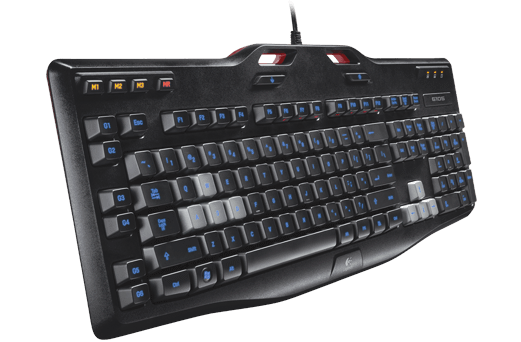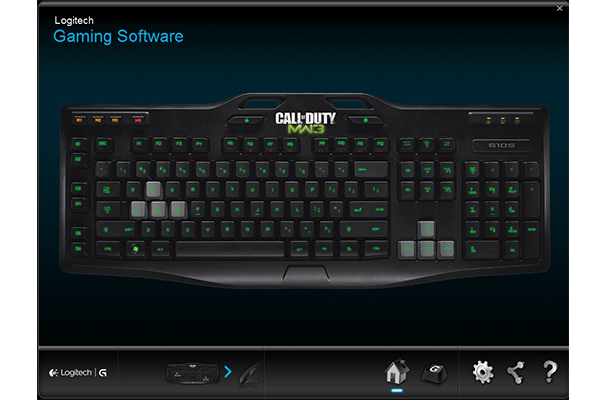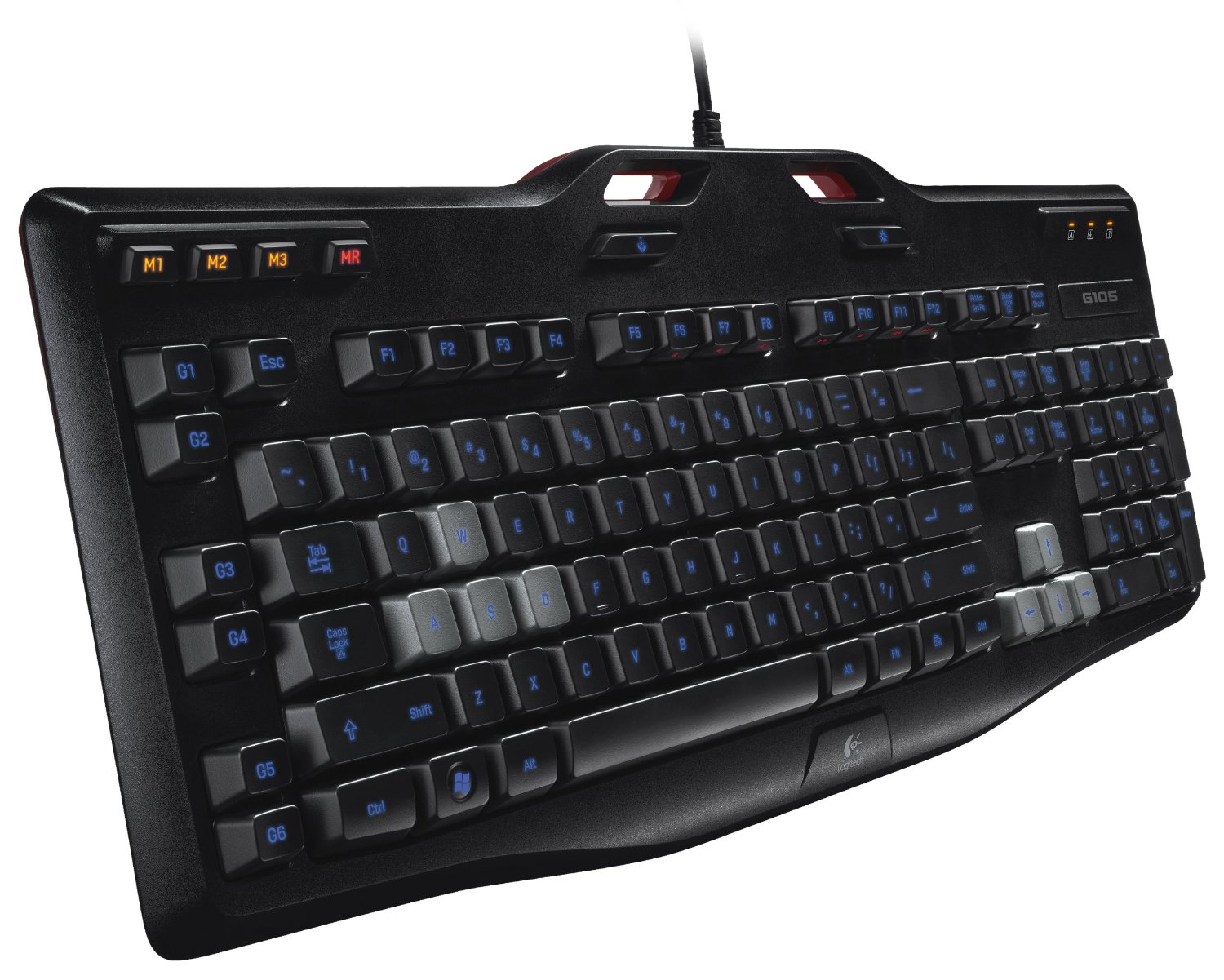Tom's Guide Verdict
The Logitech G105 has a pleasant design and decent macro functionality, but it's not much better than a standard office keyboard.
Pros
- +
Decent in-game performance
- +
Attractive design
Cons
- -
Inconsistent macros
- -
Unremarkable keys
- -
Lacks finesse of a mechanical model
Why you can trust Tom's Guide
Logitech has created some great mechanical gaming keyboards at affordable prices, which makes it somewhat baffling that it would also produce such a sub-par membrane model. The Logitech G105 ($60) is not terrible as membrane keyboards go, but it's not the best choice for people who want to game at anything more than a casual level, and it's a moderately expensive choice for those who do.
Design

The G105 measures a respectable 19.6 x 8.8 inches, making it quite a bit smaller than behemoths such as the Corsair Vengeance K95 (21.5 x 9.6 inches) and bigger than tenkeyless models like the Poseidon ZX (14.3 x 5.6 inches). If your desk can fit a standard office keyboard, it will probably fit the G105.
MORE: Best Gaming Keyboards
One of the few noteworthy things about the G105 is its illumination. The box boasts that the keyboard sports three illumination settings, although those are really just bright, dim or off. I reviewed a special Call of Duty: Modern Warfare 3 edition (that's how long the G105's been on the market), which lit up green, but most models have blue lighting — so color coordinators, take note.
Keys

A keyboard is only as good as its keys, and this is where the G105 falls down in a big way. Some people really do prefer membrane keyboards, but there's no denying that the membrane keyboard's day as a top-notch gaming peripheral has passed. Membrane offers very little in the way of tactile feedback, and if a switch malfunctions, it's not easy to replace.
If you haven't used a membrane keyboard in a while, I'll remind you why you ditched it: Membrane keys are very quiet, as they take very little effort to activate. They feel mushy and unsatisfying. Unlike mechanical keys, which run the gamut from quiet Reds to explosive Greens, membrane keys come in only one flavor.
Typing on the G105 felt just the same as typing on a standard Dell office keyboard, which is the most damning thing I can say about its functionality as a gaming peripheral. In the Ten Thumbs Typing Test, I scored 101 words per minute with a 1-percent error rate on a standard Dell and 98 words per minute with a 1-percent error rate on the G105. The G105 is not much different from a standard keyboard, for better or for worse.
Get instant access to breaking news, the hottest reviews, great deals and helpful tips.
The G105 also sports an extra row of six macro keys. I found that these keys were generally easy enough to reach using my left pinky, but I did often click them by mistake when searching for the Esc key.
Features

Arguably the best thing about the G105 is that it works with the excellent Logitech Gaming Software. By using this software, players can customize individual keystrokes, program the macro keys and set up key profiles for individual games. The G105 has three default profiles, but linking games with profiles gives users a theoretically infinite number.
The ability to program individual profiles is always welcome, although there's always the question of how useful most users will find this feature. Making button shortcuts on a mouse makes them more convenient; keyboard profiles only make sense if a gamer plays multiple games with a lot of macros.

Still, setting up profiles is as easy as it can be, thanks to the Logitech Gaming Software scanning your machine and automatically setting up profiles for every game you have installed. The software also recognizes what each key does within each game, meaning that you can assign "Melee" in Titanfall rather than just the C button.
Although it's extremely easy to record macros on the fly, we found that the timing was often off. Queuing up a very specific set of skills in Star Wars: The Old Republic did not work, as the keyboard interpreted all of our commands at the same time rather than a few seconds apart. Programming timed macros in the gaming software worked fine, but it's hard to tell exactly what the timing should be outside of regular gameplay.
Aside from the software, the G105 doesn't have many other defining features. You can disable the Windows key while gaming to prevent accidentally closing out, but this is pretty standard as gaming keyboards go.
Performance

The G105 ran the standard battery of Tom's Guide games as well as any membrane keyboard would. I played chunks of Titanfall, StarCraft II: Heart of the Swarm, Watch Dogs, and Star Wars: The Old Republic without any major problems, but nothing stood out as remarkable, either.
Mashing keys repeatedly in Titanfall and The Old Republic was still functional but did not feel as responsive as with a mechanical keyboard. Whether tactile feedback has a significant impact on how you game is a fair question, but there was very little to be had here either way.
MORE: Best Gaming Mice
For games such as Heart of the Swarm or Watch Dogs, where keystrokes are more measured and precise, the G105 worked just fine. We had no trouble ordering our Zerg armies around a map or toggling through our weapons to take on militia goons in Chicago.
The ability to program macros came in handy for The Old Republic, but as mentioned above, the on-the-fly macro recording did not work as well as we had hoped.
The G105 features six-key rollover, meaning that it can process commands from six keys at once. This isn't as many as some of its competitors, which range up to 10 (one for each digit) and beyond.
Bottom Line
There's nothing really wrong with the G105, but it's hard to find any reason to recommend it, either. Membrane keyboards are an affordable alternative to a limited range of mechanical options, but if you're going to dish out $60 for a keyboard that feels bland, you might be better served by holding off until you can afford a mechanical keyboard like the $130 Corsair Vengeance K70, or just getting a regular keyboard for $20 or so.
The G105 has a pleasant design and decent macro functionality, but otherwise, you'd be just as well off with a standard office keyboard.
Specs
Actuation: 65 g
Key Travel: 3.8 mm
In-Key Rollover: 6 keys
Size: 19.6 x 8.8 x 1.6 inches
Weight: 2.5 pounds
Marshall Honorof is a Staff Writer for Tom's Guide. Contact him at mhonorof@tomsguide.com. Follow him @marshallhonorof and on Google+. Follow us @tomsguide, on Facebook and on Google+.

Marshall Honorof was a senior editor for Tom's Guide, overseeing the site's coverage of gaming hardware and software. He comes from a science writing background, having studied paleomammalogy, biological anthropology, and the history of science and technology. After hours, you can find him practicing taekwondo or doing deep dives on classic sci-fi.
-
NotATool "Cons:Unremarkable keys; Lacks finesse of a mechanical model"Reply
Show me the 40 USD(the price on amazon) mechanical keyboard. That's like saying this Toyota is shit it's not lined with hand rolled leather that you find a Bentley. Just because they both are keyboards doesn't make them comparable from a consumer standpoint.
-------------------
"Membrane offers very little in the way of tactile feedback, and if a switch malfunctions, it's not easy to replace."
But keys are switches there is no reason for tactile feedback, just all the way down on not all the way down off. It's a switch not a Potentiometer. Tactile feedback isn't necessary for normal operation.
Also you're acting like replacing a mechanical switch is easy, mechanical keyboards don't come with plug and play switches, you have to do a ton of things to replace a switch. All you have to do with a membrane keyboard is clean the circuit and check if it's damaged. Plus membrane keyboards are far more robust when it comes to dust, liquids and crumbs. All things mechanical switches can be quite iffy with over time.
------------------------
"If you haven't used a membrane keyboard in a while, I'll remind you why you ditched it: Membrane keys are very quiet, as they take very little effort to activate. They feel mushy and unsatisfying. Unlike mechanical keys, which run the gamut from quiet Reds to explosive Greens, membrane keys come in only one flavor."
Mushy: means soft.
Mechanical movement is much harder than say your quiet reds, if anything reds would be perfectly described as mushy a light linear switch with no feedback where the actuation point is. So Mechanical MX Cherry red switch would be musher than any given membrane keyboard. Thus MX Cherry Red are unsatisfying but then again that wouldn't be feeding into the narrative to justify buying expensive mechanical keyboard.
----------------------
"Although it's extremely easy to record macros on the fly, we found that the timing was often off. Queuing up a very specific set of skills in Star Wars: The Old Republic did not work, as the keyboard interpreted all of our commands at the same time rather than a few seconds apart. Programming timed macros in the gaming software worked fine, but it's hard to tell exactly what the timing should be outside of regular gameplay."
Under LGS you can set click on the Gear and check "record delays during quick macro creation" for quick macros to record your delays in-between button presses, you never had to add timing to your macros you just never bother to change the default setting. Simply showing a failure to actually try to given the keyboard an honest chance.
-----------------------
"There's nothing really wrong with the G105, but it's hard to find any reason to recommend it, either. Membrane keyboards are an affordable alternative to a limited range of mechanical options, but if you're going to dish out $60 for a keyboard that feels bland, you might be better served by holding off until you can afford a mechanical keyboard like the $130 Corsair Vengeance K70, or just getting a regular keyboard for $20 or so."
$130 is more than double $60. K70 can find for $110 on amazon G105 can be found for $40.
You also state
"Some people really do prefer membrane keyboards"
Yet this preference is far more important than anything else when deciding to buy a keyboard apparently. Also as shown above the characteristics "mushyness" would perfectly describe cherry mx reds, so i find it hilarious that the K70 you give as an example come in MX red variant. Altough that one is $114 on amazon.
And it is a preference when it comes to games, SC1 pros where brutalizing cheap $5 keyboards pulling 400 apm without skipping a beat. Ofc the only difference is that would burn though them in a month after bashing on them 8+ hours a day more than any one would.
-------------------
You want to know the main problem with membrane keyboard and no they are all not the same different synthetics are used and made with different sizes and thicknesses which given different characteristics which you'll never bother to learn.
But the main problem is they wear down and will begin to use less and less actuation force to press them down as they become used, in other-words they lack consistency in actuation force over the long term. To a much less extent mechanical switches suffer this as well but it's less of an extent and thus unnoticeable.
-------------------
This self fulling opinionated fluff just reminds me of the idiots asking if they could shove mx cherry switches into their mice because "mice need mechanical switches too!". Those idiots couldn't even understand that mice always had mechanical switches of a different type but essentially leaf springs the same.
-
gopher1369 I genuinely don't get this review. It appears to read: Don't buy this £25 keyboard because a £90 keyboard is better (I'm in the UK).Well, yes, obviously the keyboard that's nearly 4 times more expensive is better. But not everyone can afford £90 for a keyboard, or those people that want to game, have a budget of £25, is this a good option or not? The review completely fails to answer this question.Reply -
LostAlone The point is that it's more expensive than a cheap keyboard with no particular upsides - How can you guys not see that? The point is that you can get a solid, normal keyboard for a few bucks, and this is literally just that with some tiny, mostly worthless additions. The point is that just calling it a 'gaming keyboard' doesn't justify doubling the price over a generic usb keyboard. The point is that you don't get quality simply by buying the logitech brand. The point is that you get NOTHING of what you think you are getting when you spend more than a few dollars on a keyboard. The point is that you get what you pay for, and adding a crappy, cheap, membrane keyboard to a range that is otherwise entirely mechanical and high end is a cynical cash grab that is aimed to pray on those who don't know better. That's why.Reply -
XaVierDK The only thing I'd remark is that Logitech have only ever made one mechanical keyboard: The G710+.Reply
The rest of the review is just... Bland. -
gopher1369 Reply13984790 said:The point is that you can get a solid, normal keyboard for a few bucks, and this is literally just that with some tiny, mostly worthless additions.
So the main 2 main reasons I bought this keyboard (other than price) are for its backlit keys and programmable macros. Both of these are absolutely vital to me for gaming (Try playing MMOs without macros!). I'm quite happy for you to change my mind on this, so here's the challenge: find another keyboard that also has these 2 features that you can buy in the UK for under £20. Find one and I'll hold my hands up and admit I'm wrong. And also probably buy that keyboard and recommend it to friends.
(because tone is often difficult to convey in text, to be clear I am not be facetious. If there is a good, cheap gaming keyboard available I really would like to know about it). -
ChipHazard22 This review is garbage. Bringing mechanical into a discussion of a $40 keyboard is ludicrous. Backlighting alone makes this worth it. Let me add that yes, there are other backlit keyboards for cheaper but they all are horribly dim and uneven to the point that you cant see the keys well in any setting. Also, the membrane on this board is substantially more tactile than cheapie dell boards that feel like peanut butter is stuck in your keys.Reply

